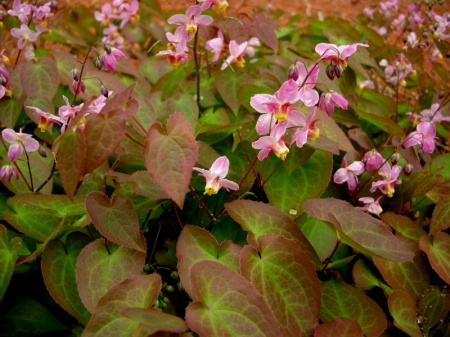 What could be more beautiful than the exquisite and delicate bicolor flowers of ‘Tama No Gempei’ epimedium?
What could be more beautiful than the exquisite and delicate bicolor flowers of ‘Tama No Gempei’ epimedium?
We have had epimediums in our garden for many years, developing large patches of the few cultivars available for sale. However, my infatuation with this genus truly began in 2006 when I attended an open house at Garden Vision Epimediums in Massachusetts and was exposed to the lovely variations in flower and leaf color, habit, and leaf shape within this beautiful group of plants.
In the last couple of years, unusual epimediums have become more available from wholesale growers, allowing us to expand the varieties we sell to our customers and plant in our own gardens. Although I generally don’t collect plants, at last count there were 33 epimedium cultivars at Carolyn’s Shade Gardens, and there is always room for more.
I am dedicating this post to Pennsylvania Governor Tom Wolf and Philadelphia Mayor Jim Kenney and all the governors and mayors across America who have stepped forward to make the difficult and often unpopular decisions necessary to keep us safe. In the face of their dedication, any sacrifice that we are asked to make seems minor. Please stay home to save lives.
Nursery News: Carolyn’s Shade Gardens is a retail nursery located in Bryn Mawr, PA, specializing in showy, colorful, and unusual plants for shade. The only plants that we ship are snowdrops within the US. For catalogues and announcements of local events, please send your full name, mailing address, and cell number to carolyn@carolynsshadegardens.com and indicate whether you are interested in snowdrops. Click here to get to the home page of our website for catalogues and information about our nursery and to subscribe to our blog.
. ‘Sulphureum’ epimedium with yellow flowers and evergreen leaves is probably the most familiar epimedium in American gardens. It spreads quickly (for an epimedium) to make an excellent groundcover, here around the base of an edgeworthia.
‘Sulphureum’ epimedium with yellow flowers and evergreen leaves is probably the most familiar epimedium in American gardens. It spreads quickly (for an epimedium) to make an excellent groundcover, here around the base of an edgeworthia.
Epimedium is the botanical name of the genus but is often used as the common name as well along with barrenwort, fairy wings, bishop’s hat, and horny goat weed(?), among others. It grows in part to full shade and prefers well-drained to dry conditions. Most of our epimediums thrive on our back hillside among hostas and ferns; however, they also do well in average soil in our level perennial borders.
Epimediums bloom in March and April, starting up just as the last snowdrops are going by. Although a large patch of epimediums in full bloom is gorgeous from a distance, to truly appreciate the astonishing beauty of these plants, I like to view them up close.
.
 ‘Yubae’ epimedium on the right with the orange flowers of Epimedium x warleyense in the top left corner. Despite the size of this patch, ‘Yubae’ is fairly slow growing.
‘Yubae’ epimedium on the right with the orange flowers of Epimedium x warleyense in the top left corner. Despite the size of this patch, ‘Yubae’ is fairly slow growing.
.
.
 Orange-flowered E. x warleyense, here with Hosta montana ‘Aureomarginata’, is an older cultivar but still one of my favorites. It grows quickly for an epimedium and makes a great, evergreen groundcover.
Orange-flowered E. x warleyense, here with Hosta montana ‘Aureomarginata’, is an older cultivar but still one of my favorites. It grows quickly for an epimedium and makes a great, evergreen groundcover.
.
 The beautiful and delicate leaves of epimediums are held aloft on wiry stems and provide a unique look and texture in the garden. This is ‘Sweetheart’ epimedium, which, after 14 years, has formed a large patch at the base of a magnolia.
The beautiful and delicate leaves of epimediums are held aloft on wiry stems and provide a unique look and texture in the garden. This is ‘Sweetheart’ epimedium, which, after 14 years, has formed a large patch at the base of a magnolia.
.
 ‘Sweetheart’ has heart-shaped leaves outlined in red and dark pink and white striped flowers.
‘Sweetheart’ has heart-shaped leaves outlined in red and dark pink and white striped flowers.
. The red in the flowers of ‘Domino’ epimedium is echoed in the breathtaking, elongated, spiky leaves, making it another favorite. It also has the desirable characteristic of reblooming in late spring, and its leaves are evergreen.
The red in the flowers of ‘Domino’ epimedium is echoed in the breathtaking, elongated, spiky leaves, making it another favorite. It also has the desirable characteristic of reblooming in late spring, and its leaves are evergreen.
. There are many epimediums with purple flowers, but ‘Pierre’s Purple’ is one of the best. It has fine-textured leaves that are bronze-purple in the spring.
There are many epimediums with purple flowers, but ‘Pierre’s Purple’ is one of the best. It has fine-textured leaves that are bronze-purple in the spring.
. Epimedium pinnatum ssp. colchicum has brilliant and early-blooming yellow flowers. It makes a very good, evergreen groundcover.
Epimedium pinnatum ssp. colchicum has brilliant and early-blooming yellow flowers. It makes a very good, evergreen groundcover.
.
 ‘Cherry Tart’ has also formed a large swath after 14 years in our garden.
‘Cherry Tart’ has also formed a large swath after 14 years in our garden.
.
 The cheerful flowers of ‘Cherry Tart’ often have me kneeling on the ground for a closer look.
The cheerful flowers of ‘Cherry Tart’ often have me kneeling on the ground for a closer look.
.
 The reddish leaves of Epimedium lishihchenii are quite striking from a distance.
The reddish leaves of Epimedium lishihchenii are quite striking from a distance.
.
 Epimedium lishihchenii‘s two-toned lemon yellow flowers also deserve a closer look.
Epimedium lishihchenii‘s two-toned lemon yellow flowers also deserve a closer look.
.
 Epimedium stellulatum “Narrow Leaf Forms” is the earliest cultivar to bloom in our garden.
Epimedium stellulatum “Narrow Leaf Forms” is the earliest cultivar to bloom in our garden.
.
 ‘Pink Elf’ also blooms early and produces a multitude of flowers.
‘Pink Elf’ also blooms early and produces a multitude of flowers.
.
 Another favorite, reblooming ‘Kaguyahime’, has two-tone purple flowers and elongated, jagged-edged, purple-splashed leaves (bottom center of photo).
Another favorite, reblooming ‘Kaguyahime’, has two-tone purple flowers and elongated, jagged-edged, purple-splashed leaves (bottom center of photo).
.
 In the spring, ‘Frohnleiten’ has reddish-bronze leaves with eye-catching lime green veins topped by sulphur-yellow flowers. It makes a fast-growing, for an epimedium, evergreen groundcover.
In the spring, ‘Frohnleiten’ has reddish-bronze leaves with eye-catching lime green veins topped by sulphur-yellow flowers. It makes a fast-growing, for an epimedium, evergreen groundcover.
.
 The pale copper-pink and yellow flowers combined with the intense red foliage make ‘Cupreum’ a standout.
The pale copper-pink and yellow flowers combined with the intense red foliage make ‘Cupreum’ a standout.
.
 A tiny epimedium, ‘Bandit’ fits perfectly in our rock garden and has unusual, dark purple-black banded leaves and pure white flowers.
A tiny epimedium, ‘Bandit’ fits perfectly in our rock garden and has unusual, dark purple-black banded leaves and pure white flowers.
Blogs are a lot more fun for everyone, especially the writer, when readers leave comments. Scroll down to the end of the page to the box where it says “Leave a Reply” and start typing—-it’s easy!
Carolyn
.Notes: Every word that appears in orange on my blog is a link that you can click for more information. If you want to return to my blog’s homepage to access the sidebar information (catalogues, previous articles, etc.) or to subscribe to my blog, just click here.









































































